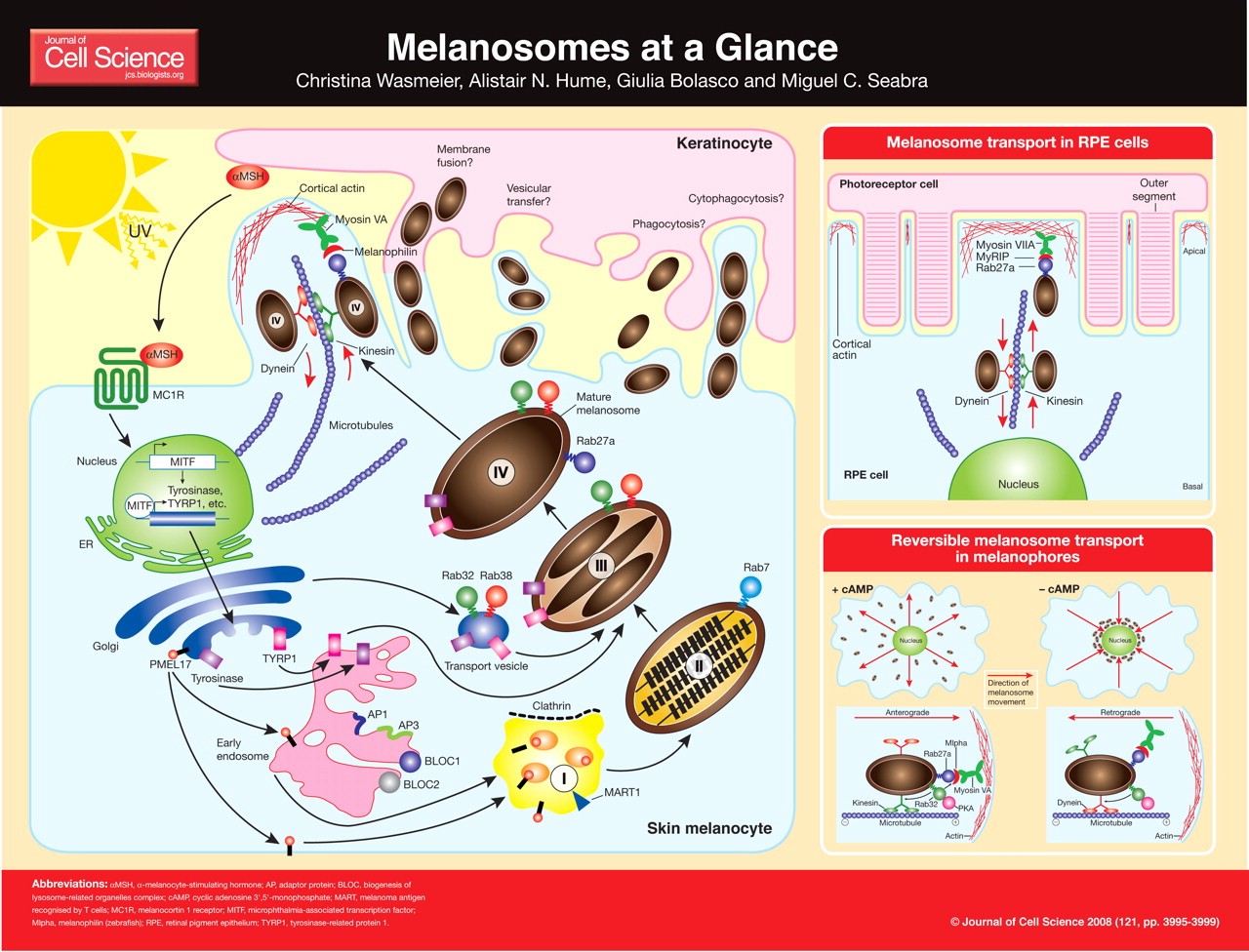Researchers have identified vesicles containing micro-RNA are important in the aggressive biologic behavior of melanoma, a cancer that kills via metastasizing to distant sites from primary tumors that are quite small.
What are exosomes?
We have discussed exosomes previously on the blog. Briefly, Exosomes are small (30–90 nm) extracellular vesicles derived from the multivesicular body (MVB) sorting pathway. These vesicles are produced by a wide variety of cell types including reticulocytes, epithelial cells, neurons, and tumor cells (Thery et al., 2009). Exosomes have been isolated from bronchoalveolar lavage, urine, serum, bile, and breast milk (Thery, 2011). Although previously considered to be cellular waste products (Thery, 2011), recent studies have demonstrated that exosomes are “bioactive vesicles” that promote intercellular communication and immunoregulatory processes by shuttling molecules between cells (Thery et al., 2009; Pegtel et al., 2010). Exosomes are lipid-bilayer-enclosed extracellular vesicles that contain proteins and nucleic acids, including miRNA’s (inhibitory RNA sequences).

Exosomes carry a wide array of molecules including proteins, DNAs, mRNAs, and miRNAs, depending on a variety of factors including the cell type from which the exosome originates, the state of health of the host, and extracellular stimuli. The contents of exosomes can be transferred from origin cells to target cells, resulting in an elaborate intercellular communication network. Exosomal miRNAs confirmed by different methods (e.g., microarray and qPCR) under different pathological conditions are listed in this figure. http://journal.frontiersin.org/article/10.3389/fgene.2012.00056/full
Conditioning the tumor microenvironment
With respect to the melanoma discovery by researchers from Tel Aviv University:
“The threat of melanoma is not in the initial tumor that appears on the skin, but rather in its metastasis–in the tumor cells sent off to colonize in vital organs like the brain, lungs, liver and bones,” said Dr. Carmit Levy of the Department of Human Molecular Genetics and Biochemistry at Tel Aviv University’s Sackler School of Medicine in a statement. “We have discovered how the cancer spreads to distant organs and found ways to stop the process before the metastatic stage.”
It was previously known that melanomas develop in the epidermis, the outermost layer of skin. Early-stage melanoma is unable to metastasize because it has no blood vessels and no access to the body’s blood vessels, including some in the dermis. Levy’s team set out to uncover how the tumors eventually make this connection.
“We found that even before the cancer itself invades the dermis, it sends out tiny vesicles containing molecules of microRNA,” Dr. Levy said. “These induce the morphological changes in the dermis in preparation for receiving and transporting the cancer cells. It then became clear to us that by blocking the vesicles, we might be able to stop the disease altogether.”
The scientists sought chemicals to attack this process and landed on two: SB202190 inhibits the delivery of the vesicles from the tumor to the dermis, while U0126 wards off the changes in the dermis even after the vesicles have been released.
Melanosomes versus exosomes
The miRNA’s are contained in melanosomes, the pigment granules that provide tissues with color and photoprotection, are the cellular site of synthesis, storage and transport of melanin pigments.
Melanosomes are lysosome-related organelles, which comprise a diverse group of specialised compartments, most of which contain secretory cargoes. Unlike classical secretory granules, lysosome-related organelles share some proteins (e.g. LAMP1) with lysosomes and appear to be derived from endosomes. The endosomal system is highly dynamic and consists of multiple functionally distinct compartments and subdomains. In melanocytes, some of these have been adapted to serve specialized roles in the biogenesis of melanosomes.
Melamoma induces fibroblasts to differentiate into CAFs (cancer associated fibroblasts), which transform the micro-environment, inducing proliferation, angiogenesis, and migration.
Specifically, melanosomal microRNA-211 directly targets IGF2R and leads to MAPK signaling activation, which reciprocally encourages melanoma growth. MicroRNAs (miRNAs) are small noncoding RNAs that suppress gene expression. miRNAs regulate many physiological and pathophysiological processes such as development, differentiation and cancer. Compared with primary fibroblasts, CAFs have increased rates of proliferation and ability to migrate, promote inflammation, angiogenesis and tumor growth, and express α-SMA (alpha smooth muscle actin, which stimulates fibroblast contractility).
Melanosome Inhibitor SB202190
SB202190 is a p38 (a MAPK kinase that triggers endocytic trafficking) inhibitor that inhibits melanosome secretion from melanocytes.
SB202190 significantly reduced (sixfold) the number of secreted melanosomes without affecting the exosome number. Also, a decrease in melanin content in melanoma medium and melanin accumulation in fibroblasts was observed, indicating that SB202190 treatment reduces melanosome release. Additionally, downregulation of tyrosinase expression was observed in fibroblasts, indicating decreased melanosome absorption. These results suggest that inhibition of melanosome transfer from melanoma cells to fibroblasts abrogates fibroblast reprogramming into CAFs.
ERK Inhibitor U0126
ERK is a transcription factor that transolocates to the nucleus when phosphorylated as part of the MAPK pathway.
Inhibiting MAPK signaling using the ERK inhibitor U0126 concurrently with miR-211 transfection or melanosome treatment abolished the effect of miR-211 and melanosomes on fibroblast migration, proliferation and on the expression of pro-inflammatory markers.
Both SB202190 and U0126 could be useful in the treatment of melanoma.

